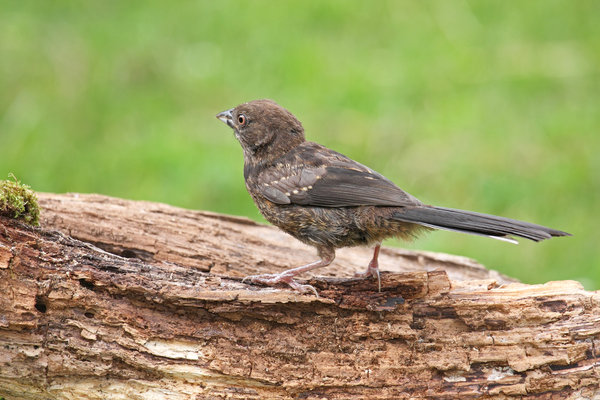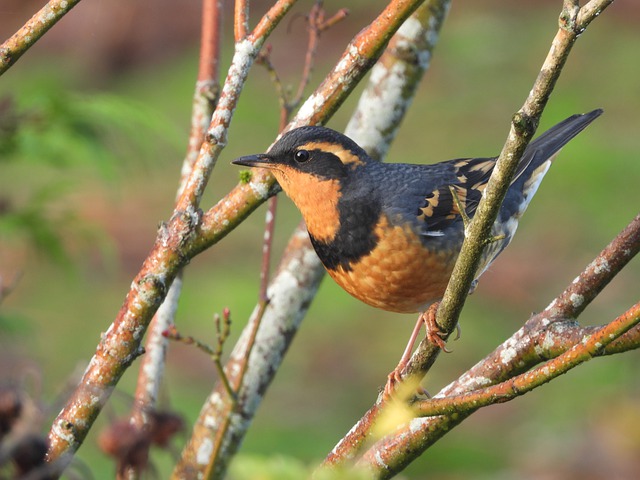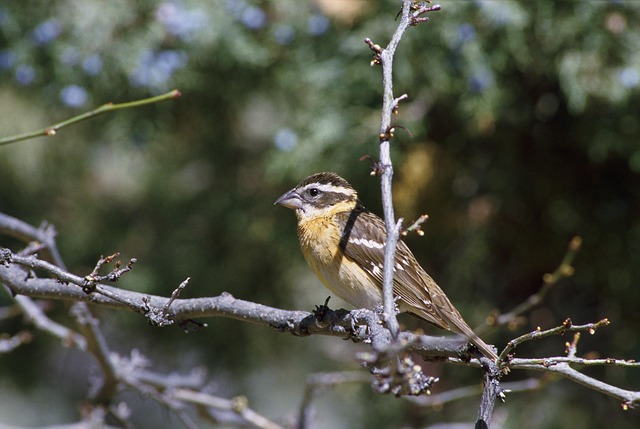Hello, bird enthusiasts!
Welcome to an exciting article where we explore the fascinating world of avian look-alikes.
In this piece, we’ll take a closer look at five birds that bear a striking resemblance to robins but, intriguingly, are not robins at all.
Prepare to be amazed as we unravel the mysteries of these avian doppelgangers and discover the unique characteristics that set them apart.
So, without further ado, let’s embark on this journey to uncover the secrets of these five birds that look like robins but aren’t!
| Image | Bird | Features | Price |
|---|---|---|---|
 |
| 9.7 | Check Price |
 |
| 9.5 | Check Price |
 |
| 9.1 | Check Price |
 |
| 8.8 | Check Price |
 |
| 8.6 | Check Price |
If you don’t have the time to read the whole article, check out this video on 5 Birds That Look Like Robins but Aren’t for a quick understanding.
Birds That Look Like Robins but Aren’t
1. Spotted Towhee

The Spotted Towhee is a Xerox copy of the American robin, and it will take a closer observation to identify whether it is a robin or Towhee.
They reside in many states of the United States, ranging from Washington, California, to the most western coast of the Pacific; besides the western end of the United States, they can also be easily found in Oregon, Utah, Sothern, and British Colombia.
The Spotted Towhee, a robin-like bird with an orange and black breasts, is a gorgeous and brilliantly colorful bird.
The Spotted Towhee inhabits a wide range of habitats, including coastal regions and islands; as we have discussed above, they are found in abundance on the westernmost Pacific coast of the United States.
It nests in marshes during the dry and cold spring and summer seasons then returns to its woodland to eat throughout the winter.
Despite these resemblances, if you have know-how about these birds, you can identify them.
Below we are going to mention some differences that will help you differentiate between the two species.
One of the most prominent differences is that robins are rusty in color. Whereas the spotted Towhee have rufous sides, and most of the belly part is of white color, and Robin’s belly is mostly covered by their rusty dominant color.
Besides these, you can spot tiny dots of white color on the back and wings of towhees.
When it comes to size, robins have a bigger frame than the spotted Towhee.
The spotted Towhee has a black color bill while robins have yellow.
Moreover, the biggest difference as the name suggests is spotted towhees which means that they have spots on all their body.
The blackheads of the robins and spotted towhees are that which make the two birds look similar.
Both have tails of bigger length and overall body size.
Below are the characteristics of the Spotted Towhee,
| Scientific Name | Pipilo maculatus |
| Family Name | Passerellidae |
| Length | 7-9 inches (18-23 cm) |
| Weight | 1.2-1.8 ounces (34-50 grams) |
| Wingspan | 8.7-10.6 inches (22-27 cm) |
| Habitat | Dense shrubs, thickets, woodlands, forests, and brushy areas |
| Food | Seeds, insects, spiders, fruits, berries, and small invertebrates |
2. Varied Thrush

Varied Thrush are nomad birds that tend to migrate a lot, and they breed around the Alaska region, northern California, and the western bank of the United States.
They like to live in the backyard, mixed woodlands, and also park for their sustenance.
They recurrently pay a visit to the upper part of the Midwest during the winter season and also the northeast.
The Varied Thrush is a big, virtually featherless bird belonging to the Ixoreus genus.
They’re native to North America, but they’re found all around the world, and they’re sometimes mistaken for other common songbirds like the Robin.
They are, however, considerably diverse in terms of body shape and size, as well as in terms of their songs.
Varied and robins are of the same length.
They have a bill of great strength and are spherical-headed, and have a body that is sturdy.
Robins and varied thrush have the same orange-rusty color, and their feathers resemble a lot.
Males are usually blue-gray, and females are slightly brownish in color.
You need to closely observe while looking for a varied thrush because, as we have discussed earlier that they have the same orange color, but one thing that is important and you also should take notice of is that they have a more vibrant orange color when it comes to comparing them with robins.
Moreover, there are also orange spots on the wings of the varied thrush, and these spots can also be seen on the eyes and back of these birds.
Generally, both of the birds have the same small length, but a keen observation depicts that varied thrush is comparatively shorter than the robins.
The tails of the robins have great length when compared with the varied thrush.
The body structure and the body build of both birds are nearly identical.
Also, the rusty orange color of both the birds makes them look the same.
These features of the varied thrush make them similar to the robins.
Below are the characteristics of the Varied Thrush,
| Scientific Name | Ixoreus naevius |
| Family Name | Turdidae |
| Length | 8.3-9.8 inches (21-25 cm) |
| Weight | 2.3-2.9 ounces (65-83 grams) |
| Wingspan | 13-15 inches (33-38 cm) |
| Habitat | Coniferous and mixed forests, mountainous regions, and wooded areas near water |
| Food | Insects, spiders, snails, earthworms, berries, fruits, and seeds |
3. Eastern Towhee

The eastern Towhee, like the Robin, is a fairly big New World sparrow with striking red and orange feathers.
Towhees have a habit of nesting around or in abandoned beech trees, which is a frequent trait.
This might be due to their proclivity for building nests in abandoned tree branches and hollow logs; these characteristics could explain their frequent occurrence.
When the eastern Towhee was initially discovered in 1774, it was assumed to be a distinct species belonging to the same family as the common Robin.
You can see these birds usually in the great lakes region in the southern part of Canada, and besides that, they are along the Atlantic seaboard of the United States.
They tend to live in bushy or low-bushy parts of the United States.
Their belly is an off-white color, and the black usably covers all the body parts and the upper portion and above head region.
Besides this, the rufous side makes them appear ditto to robins.
The average length of the eastern Towhee is around 18 to 24 cm.
The body’s rufous color is the most prominent feature of the two birds that make both birds appear the same.
Both have necks and heads of the same black color.
Moreover, the lengths of their tales are also the same.
The Eastern Towhee and the American Robin share some characteristics.
Like the spotted Towhee, the Eastern Towhee’s rufous hue only covers the sides.
Towhees have white bottom portions, whereas Robins have a burnt orange coating.
The bill is trapezoidal and shorter in the Eastern Towhees. Furthermore, the top body colors of these two species differ.
The Eastern Towhees are smaller than the American Robins.
Below are the characteristics of the Eastern Towhee,
| Scientific Name | Pipilo erythrophthalmus |
| Family Name | Passerellidae |
| Length | 6.8-9 inches (17-23 cm) |
| Weight | 1.2-1.8 ounces (34-50 grams) |
| Wingspan | 7.9-11 inches (20-28 cm) |
| Habitat | Brushy areas, thickets, young forests, woodland edges, and shrubby clearings |
| Food | Seeds, insects, spiders, fruits, berries, and small invertebrates |
4. Common Redstart

The Common Redstart is a small passerine bird that resembles the Robin.
It’s a migratory bird that spends the winter in Africa.
It’s common in the United Kingdom and East European lowlands. Birch and oak woodlands, as well as low shrub patches, are common ecosystems.
The Parulidae family includes the Common Redstart. Because of their black plumage and orange breast, they are frequently mistaken for Robins.
These birds may be found in Florida’s central and northern regions.
Large cities, suburbs, small villages, and even country areas are all home to it.
The male is usually highly colorful and domineering, whilst the female is considerably quieter and less aggressive.
On your front porch or patio is a perfect area to put a bird feeder.
These birds can also be seen in backyards among huge trees.
Because of their brilliant colors and capacity to provide life to any environment, they are a favorite target for bird watchers.
Berries, insects, and various seeds are favorites of these birds.
To attract a mate, the female will typically spread out her wings and make a call to give a sign to males that she is ready for mating.
It’s no surprise that this bird has become a popular species in New Hampshire, Connecticut, and Florida because of these characteristics and its lovely colors.
The body shape of the common redstart is slim and has a decent length.
They are among the small bird species, and on average, they have lengths of 13 to 14 cm.
They contain an elongated orange rusty color tail.
Beneath the wings, the body is also of the same color as the tail.
Their faces are black, and the crowns are of white color.
There are most likely chances that you will take a common redstart for a robin.
It is pretty common, and you need to observe them closely if you need to differentiate between a robin and common redstart.
Redstarts have a forehead of white color, whereas there are white circles that are covering the eyes of robins.
Besides that, you can also differentiate by observing the beaks of the common redstarts.
The black bill is also one of the peculiar features that will help you in pointing out the difference between a robin and common redstart.
The common redstart has a tail that is of more width, and that is usually absent in the robins.
Both of the birds have a rusty orange underpart.
The bills of both birds are also similar.
The color of the throat is black, which is common between the two birds.
These are some features that they both share.
Below are the characteristics of the Common Redstart,
| Scientific Name | Phoenicurus phoenicurus |
| Family Name | Muscicapidae |
| Length | 5.5-6.3 inches (14-16 cm) |
| Weight | 0.5-0.7 ounces (15-20 grams) |
| Wingspan | 8.7-9.8 inches (22-25 cm) |
| Habitat | Woodlands, forests, gardens, and scrubland |
| Food | Insects, spiders, small invertebrates, fruits, berries, and seeds |
5. Black-headed Grosbeak

The Cardinalidae family contains the black-headed grosbeak as well as the northern cardinal; most black-headed grosbeaks that aren’t already in Mexico will move there in the winter and stay until spring.
They like to reside in woodland settings with huge trees and plants, although they may also be found in wetlands and cities.
While they do build nests in bushes on occasion, they prefer to build them in trees high above the ground.
The male and female black-headed grosbeaks, unlike other songbird species, will take turns incubating their eggs.
In the summer, they eat mostly insects, while in the winter, they eat mostly seeds, berries, and fruit.
From British Columbia to the western part of the United States, the Black-headed grosbeak is a medium-sized bird.
They’re also prevalent in Central America’s south.
It’s a migratory bird that prefers deciduous and mixed-wooded habitats.
The average length of these birds is about 16 to 20 cm.
Males have soft black-colored heads, and their wings are also black in color.
These birds are heavy, and their bills are also thick.
The underpart of these birds is a blend of yellow and orange colors.
The Robins’ rusty-colored breast and belly are more brilliant than the Black-Headed grosbeaks.
The Robins lack the white markings that the grosbeak has.
The grosbeak is a smaller bird than the Robin.
The most noticeable orange and yellow bottom portions are the most perplexing feature in distinguishing this species from Robins.
Despite the fact that they are smaller than robins, their body shapes are very similar.
In addition, they both have blackheads.
Below are the characteristics of the Black-headed Grosbeak,
| Scientific Name | Pheucticus melanocephalus |
| Family Name | Cardinalidae |
| Length | 7-8 inches (18-20 cm) |
| Weight | 1.5-1.9 ounces (42-54 grams) |
| Wingspan | 11-12 inches (28-30 cm) |
| Habitat | Deciduous forests, woodlands, riparian areas, and shrubby habitats |
| Food | Insects, spiders, seeds, fruits, berries, and nectar |
Conclusion
In conclusion, the world of birds never fails to surprise us with its diversity and captivating resemblances.
Throughout this article, we have delved into the fascinating realm of birds that bear a striking resemblance to robins, yet possess distinct identities of their own.
From the striking coloration of the European Robin to the vibrant plumage of the American Redstart, these avian look-alikes have showcased their unique adaptations and adaptations for survival.
By highlighting these five remarkable species, we have gained a deeper appreciation for the intricacies of nature and the wonders it has to offer.
So, the next time you spot a bird resembling a robin, take a closer look, for you may have discovered one of these incredible doppelgangers.
Let us continue to explore, appreciate, and protect the remarkable diversity of bird species that grace our planet.
Happy birding!
FAQ
How can I tell the difference between a robin and these look-alike birds?
While these birds may share similar physical features, there are key distinguishing characteristics to help differentiate them. Pay attention to factors such as color patterns, size, behavior, and habitat preferences.
Do these look-alike birds have similar habits and behaviors as robins?
While some behaviors may overlap, each species has its unique habits. For instance, the American Redstart is known for its energetic and acrobatic foraging behavior, while the European Robin is famous for its territorial singing.
Are these look-alike birds found in the same regions as robins?
The distribution of these birds varies. For example, the European Robin is commonly found in Europe, while the American Redstart is native to North America. It’s important to consult field guides or reliable resources to determine their specific ranges.
Why do these birds have similar appearances?
Convergent evolution plays a role in the similar appearances of these birds. They may have adapted to similar ecological niches, resulting in shared physical characteristics that aid in survival and foraging strategies.
Can these look-alike birds mimic the songs of robins?
While they may have their unique vocalizations, some of these birds are known for their melodic songs, similar to those of robins. The European Robin, for instance, is renowned for its sweet and melodious singing.
Are these look-alike birds as commonly observed as robins?
The frequency of sightings can vary depending on the region and specific bird species. Some of these look-alike birds, such as the European Robin, are commonly observed in their native habitats, while others may be rarer or have more restricted ranges.
Are there any conservation concerns for these look-alike birds?
Like many bird species, these look-alike birds may face various conservation challenges, such as habitat loss, climate change, and human disturbances. Conservation efforts and awareness are crucial to protect their populations and ensure their survival.
Last Updated on June 12, 2023 by Lily Aldrin
